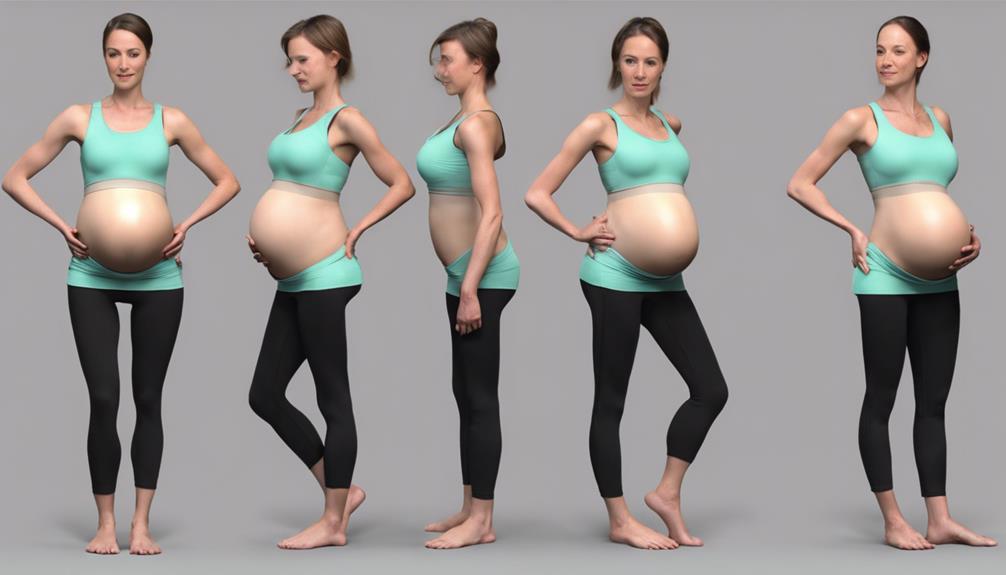Have you ever thought about when exactly the second trimester of pregnancy starts? It is commonly believed to begin at the 13th week, but is that truly correct?
Understanding the nuances of pregnancy stages is important for expectant parents, and pinpointing the exact moment when the second trimester kicks off can provide valuable insights into what to expect next.
Curious to uncover the truth behind this milestone? Let's explore this topic further to shed light on this pivotal moment in pregnancy.
Key Takeaways
- Second trimester officially begins at week 13 of pregnancy.
- Maternal energy levels increase as pregnancy symptoms like nausea decrease.
- Visible baby bump may start showing, reflecting baby's growth.
- Reduced risk of miscarriage around week 13 marks a significant milestone.
Signs of Transition to Second Trimester
As the second trimester commences at week 13 of pregnancy, a notable shift in symptoms and physical changes becomes evident, signaling the shift to this stage of gestation. One of the early signs of moving to the second trimester is the increase in maternal energy levels. Many women experience a welcome surge in energy, feeling more vibrant and active compared to the first trimester. This newfound energy can make daily tasks feel more manageable and enjoyable.
Additionally, around week 13, some women may notice the beginnings of a visible baby bump. This physical change can bring a sense of excitement and connection to the growing life within. Along with the baby bump, there's often a decrease in pregnancy symptoms like nausea and fatigue, contributing to an overall sense of comfort and well-being during this stage.
Week 13 marks a period of reduced miscarriage risk for many pregnant individuals. This milestone can provide reassurance and allow expectant parents to start feeling more confident and optimistic about the pregnancy journey ahead.
Physical Changes at 13 Weeks

During the 13th week of pregnancy, notable physical changes begin to manifest as the body shifts into the second trimester. Expectant mothers may notice a visible baby bump as the uterus continues to grow to accommodate the developing baby.
Hormonal changes also play a substantial role during this phase, often leading to increased energy levels and an overall sense of well-being. Many women find relief from symptoms like nausea and fatigue as they enter the second trimester, making this a more comfortable period of pregnancy.
The growth of the uterus not only contributes to the baby bump but also reflects the progress of the developing baby. At 13 weeks, the risk of miscarriage significantly decreases, providing expectant parents with reassurance as they navigate this stable phase of pregnancy.
Embracing these physical changes can be a rewarding experience as the body prepares to nurture and support the growing life within.
Baby's Development Milestones
At 13 weeks of pregnancy, significant milestones in the baby's development mark the formation of major organs and the initiation of bone and cartilage growth. As the baby continues to grow and develop, several key milestones can be observed:
- Vocal Cords Formation: The baby's vocal cords are starting to form, potentially allowing for tiny movements that might be felt by the mother.
- Lanugo Growth: The development of lanugo, a soft hair covering the baby's body, begins to regulate their body temperature.
- Genitalia Development: Although not yet visible on an ultrasound, the baby's genitalia is in the process of forming.
- Distinct Features: The baby's growth rate accelerates around this time, leading to the emergence of distinct features that make them resemble a miniature human.
These milestones signify the rapid progress and transformation taking place within the baby during this critical stage of development.
Maternal Health Updates

Our focus shifts to the latest updates concerning maternal health during this stage of pregnancy. As expectant mothers enter week 13, the second trimester brings about notable changes in maternal well-being. Energy levels tend to increase, and the discomforts of early pregnancy, such as nausea, often lessen. This phase, known as the 'honeymoon phase', can be a welcomed respite for many women. Additionally, the risk of miscarriage greatly decreases during the second trimester, providing a sense of relief and security.
To highlight the importance of this stage, it is vital for expectant mothers to prioritize prenatal screenings and tests. Planning for these screenings, along with sharing the pregnancy news and arranging maternity leave, should be on the agenda. Below is a table outlining key aspects of maternal health updates during pregnancy week 13:
| Aspect | Description | Importance |
|---|---|---|
| Energy Levels | Increase in energy levels and reduction in nausea symptoms | High |
| Honeymoon Phase | Decrease in early pregnancy symptoms, often a period of relief | Significant |
| Miscarriage Risk | Substantial decrease in the risk of miscarriage during the second trimester | Reassuring |
Transitioning to Second Trimester Care
Moving into the second trimester of pregnancy at week 13 brings about a shift in maternal well-being, with notable changes in energy levels and a reduction in early pregnancy discomforts. As we move into second trimester care, it's a good time to focus on our baby's development and our own health. Here's what to expect:
- Feeling Less Nauseous: Many moms-to-be start to feel less nauseous as the placenta takes over hormone production.
- Doctor or Midwife Visits: Regular health care appointments are important during this stage to monitor the baby's growth and address any concerns.
- Baby's Development Milestones: The second trimester is marked by significant milestones in the baby's development, such as organ formation and bone growth.
- Week-by-Week Guide: Following a week-by-week guide can help us track our progress and understand what's happening with our baby's growth.
Moving to second trimester care involves a collaborative effort with healthcare providers to ensure both maternal and fetal well-being.
Frequently Asked Questions
Does Second Trimester Start at 13 Weeks?
Yes, the second trimester starts at 13 weeks in pregnancy. It's a significant shift from the first trimester, marked by early fetal development. Many find the second trimester more comfortable as symptoms like nausea tend to decrease.
Does First Trimester End at 12 or 13 Weeks?
Does the first trimester end at 12 or 13 weeks? The first trimester typically concludes at 13 weeks. It's a time of significant fetal development and potential symptom relief for the mother. We can expect exciting changes as we shift into the second trimester.
Is 13 Weeks Third Trimester?
At 13 weeks, a pregnancy is firmly within the second trimester. The third trimester begins at week 27. Week 13 brings relief from early pregnancy symptoms for many, along with increased energy and the start of a baby bump.
What Are the Signs of a Healthy Pregnancy at 13 Weeks?
At 13 weeks, signs of a healthy pregnancy may include reduced nausea, a visible baby bump, functioning organs, and a detectable heartbeat. Genetic testing can also be performed to assess the baby's health at this stage.
Conclusion
As we reach week 13 and shift into the second trimester, the journey of pregnancy continues to unfold with exciting milestones ahead. Embracing the changes in our bodies and witnessing the growth and development of our baby is truly a remarkable experience.
Like a butterfly emerging from its cocoon, we're entering a new phase filled with wonder and anticipation. Let's cherish each moment and look forward to the joys that lie ahead.










